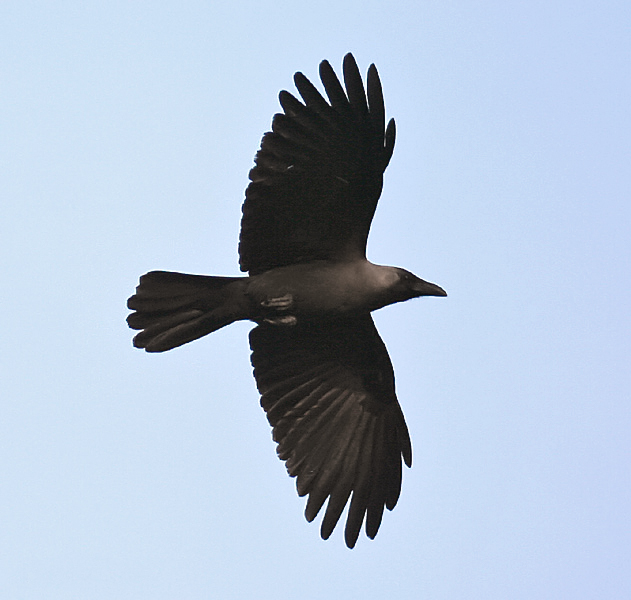 |
| Indian House Crow, not the prettiest... Thanks to Dick Daniels |
First though, identification is fairly simple: the house crow is a medium-large all black and grey bird, usually found in flocks in towns all along the coast and, in some areas, invading inland too. It is very loud, with a persistent "Carr, Carr, Carr" call that is the constant sound of Dar es Salaam bird life... There are few confusion species in East Africa, the only other common species of crow being the black and white Pied Crow, which often hangs about with the house crow.
So, what is interesting about house crows? Well, I guess the most basic fact is that they originally come from India and south-east Asia. They were actually first introduced to East Africa in the late 1890s, when they were apparently deliberately introduced to control rubbish on Zanzibar (note, that is certainly the oldest citation I've provided so far on this blog- hurrah for the British ornithologists' union digitising old issues of Ibis!). Which just goes to show quite how stupid we humans can be sometimes. Yes, they eat rubbish (lots of it too), but noone was thinking that they might also like to eat other things too- like all the eggs and chicks of small native birds, or even young chickens (meaning outdoor chicken farming is now impossible where they're very common), or young maize cobs, or, etc., etc. They also carry and possibly spread some rather nasty diseases around too. For a full list of impacts, I suggest going here.
 |
| Thanks to J M Garg |
Given their massive impacts, you'll not be surprised to hear that there's been some research on invasive species, and it would seen that the house crow is a pretty perfect example. As we've noted already, the species was deliberately introduced to East Africa, but for a long time its population was fairly restricted, and only more recently have the numbers and distribution increased massively. This slow establishment, followed by eventual massive increase is absolutely typical of successful invaders. Much of it can probably be explained by the fact that a population starts from just a very few individuals, and even exponential growth takes several generations before very large numbers suddenly seem to build up, but some of it might also be to do with the initial individuals not being perfectly adapted to local conditions, and evolving to local conditions takes several generations- but certainly can be rapid among some invasive populations. Secondly, it turns out that it is extremely difficult to predict what species will become invasive- not all introduced species establish in the new area, not all established species grow much in population, and not all alien species that establish well actually have major impacts (it turns out that each stage has a roughly 10% chance). And remarkably little will tell you whether a newly arrived species will be invasive or not, the main key being whether or not it has been invase elsewhere. And again, the Indian House Crow is a particular good example: in recent years it has managed to reach nearly everywhere, and has established populations in 4 new continents!
So now we know that the house crow can become invasive, it is interesting to know if we can predict the areas where it could possibly live, assuming that eventually it will find it's way there- as those involved in the current efforts to eradicate the species from Tanzania know, once established, it is extremely difficult to remove an invasive species, you're much better off acting before the population gets a chance to become established in the first place. Knowing where the species lives naturally, and the conditions it like to live in should give some useful information here, so recently a number of researchers have tried to build the same sorts of statistical models of distribution that we've discussed before here, and then plot where else in the world there are similar conditions, where the species is perhaps most likely to persist. Again, it's been done for house crows - and it's pretty impressive how far they might spead in the end - figure from the paper below!
But as often with these models, I'm still not totally convinced - we know there's a population in the Netherlands, which only has a very low probability in the map above - but I would be totally astonished if it can live in the Netherlands and not through Spain and Portugal, for example. In fact, several of the studies that have compared the conditions in introduced parts of a species range with those in the native range find surprisingly little agreement, with introduced species often occupying different climatic regions than the area they evolved in, so I'm not totally convinced of the value of these exercises (probably partly because the models used to predict distributions are not always statistically or ecologically sensible).
Still, all told, I hope you'll agree there is something interesting to say, even about the Indian House Crow!
Main Reference:

No comments:
Post a Comment